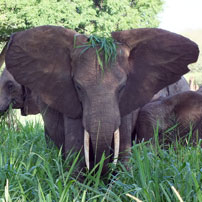 My most recent trip took me back to Tanzania once again. Having explored the remote west of the country last year, this time I followed the more traditional northern circuit.
My most recent trip took me back to Tanzania once again. Having explored the remote west of the country last year, this time I followed the more traditional northern circuit.
It’s a trip I’ve done before and I’ve always enjoyed the fantastic game viewing and stunning landscapes. This time however I really enjoyed the different dimension brought to the trip by being able to get of the vehicle and do some exploring on foot.
Tarangire National Park is an ideal first destination on your safari as it is only a three hour drive from Arusha (four hours from Kilimanjaro Airport). Sadly it is often overlooked or simply visited for a few hours as holidaymakers rush to the big-name destinations of Lake Manyara and the Ngorongoro Crater. Investing time there however is incredibly rewarding as it is such a picturesque park with towering baobabs, wide savannahs and water courses. The game viewing, particularly during the dry season (July through to October), is excellent and it is perhaps one of the best places in Tanzania in which it view large numbers of elephants as they are drawn to the impressive Silale Swamp.
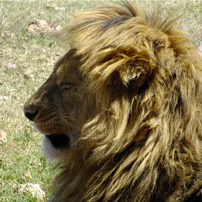
Much of its’ charm lies with the fact that it still offers an authentic safari experience with tented accommodation still being the norm rather than the exception, and unlike in the Serengeti, it is possible to do both walks and night drives from certain camps. Olivers Camp, Kuro Camp and Swala all employ their own walking guides who, along with a local parks ranger, will take you out on a big game walk and in the case of Oliver’s it is possible to add in a little more adventure with overnight fly-camping.
We often propose the Ngorongoro Highlands as being an excellent base for visiting both Lake Manyara National Park and the Crater but this time I bypassed them, and headed directly to the Ngorongoro Crater. As before, the views of the sunken caldera took my breath away and the game viewing on the crater floor was as good as I hoped with large numbers of wildebeest, lazing lions and as many hyenas as I have ever seen in one place.
It is not a secret that the Ngorongoro Crater attracts large numbers of visitors and vehicle numbers can be high, so the ability to leave the car and do some walking can be a welcome relief.
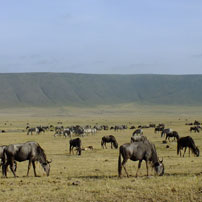
Nomad Tanzania’s Entamanu Camp has an enviable (although sometimes very windy) location close to the rim and offers the chance to stretch your legs after a day of vehicle based game viewing with an easy stroll towards the rim, stopping for sundowners as the day comes to a close. A longer walk can also be taken across the undulating countryside to a local village where I was greeted by Daniel, one the young warriors who showed me around his home with some pride. This is a living, breathing Maasai village, not a tourist village. It was sometimes necessary to watch where I stepped and the smell from the cattle boma was certainly ripe but it provided a great insight into the Masai was of life. As I was as leaving I could young voices chanting and as I walked nearer I saw a group of children sitting under a tree following their lead from the sole adult. School was in progress and there seemed to be an abundance of enthusiasm for practicing their numbers form one to ten!
Staying elsewhere in the Ngorongoro Highlands does not preclude guests from being able to walk. Dependent on where one stays and how much time is available, there are various walking options; gentle walks in the highlands, hikes to the Crater Rim and nature walks around it are all possible.
Asilia Africa’s contemporary Highland Lodge is tucked away beyond the north east rim of the Crater and as well as offering game drives on the Crater floor, it is also an excellent base for two of the more challenging walks in the area.
Dependen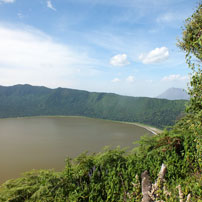 t on where you stay, a trip to Empakai Crater can be a full day excursion but from the Highlands, the hike can just about be achieved in a half day. The drive out to the crater was bumpy and dusty but for me, was an integral part of the excursion as we drove through vast rolling grasslands dotted with Masai villages where small children watched over their herds of cows or goats which in turn were contentedly sharing their pastures with wildebeest and zebra. It was a beautiful and serene scene and one that felt utterly timeless.
t on where you stay, a trip to Empakai Crater can be a full day excursion but from the Highlands, the hike can just about be achieved in a half day. The drive out to the crater was bumpy and dusty but for me, was an integral part of the excursion as we drove through vast rolling grasslands dotted with Masai villages where small children watched over their herds of cows or goats which in turn were contentedly sharing their pastures with wildebeest and zebra. It was a beautiful and serene scene and one that felt utterly timeless.
I was a bit underwhelmed by the crater when we first arrived, until I got out of the car and walked to the rim. Only then did I appreciate the natural beauty of this sunken caldera. At the base of the crater lies the salt encrusted Lake Empakai, said to be as deep as 85 metres and covering three quarters of the craters floor. Encircling the lake is a steep and densely forested wall rising 300 metres above. The forest is alive with birds and monkeys and while they are rarely seen, footprints also confirm the presence of leopard. The hike down, following an established path takes between 30 and 45 minutes but the return journey is taken at a much slower pace due to the steepness and can take over an hour.
I confess I didn’t do the hike down to Empakai but the following morning I did climb up to Olmoti Crater. The trail is an ancient one used by the Masai taking their cattle to drink and is not overly challenging in itself although the rarified air at over 10,000 feet did slow me down as I paused to drag oxygen into my lungs. Nevertheless, the climb took only 40 minutes and the view, over a more expansive depression than Empakai was definitely worth it. Below the lookout point it is possible to see the Munge River and if you are feeling fit enough, it is possible, taking an armed guard with you in case you bump into any buffalo, to clamber down to the waterfall.
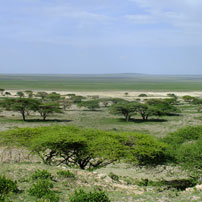
The Serengeti is of course synonymous with amazing wildlife viewing and the areas around the core game viewing sectors of Ndutu and Kusini certainly lived up to this reputation. Predator sightings were excellent as was the array of plains game. The large herds of wildebeest that I had hoped to see, were a bit more challenging as unusual rainfall patterns had fragmented them into many smaller herds which had dispersed across the southern, western and central Serengeti. Having said that, Hidden Valley lived up to its name and as we approached across the plains, plumes of dust were clearly visible. Dipping into the depression we found the reason with an impressive number of wildebeest and zebra looking for water and enjoying the salty nutrients in the soil.
Being in a national park does however bring more restrictions with walking and night drives both prohibited which makes the option of combining your stay with a camp where it is allowed an appealing one.
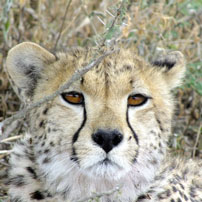 Tucked away at the southernmost end of shortgrass plains, Alex Walkers Serian South Camp is as much about the local community and varied activities as it is about the game viewing. From camp you can hear laughter and singing from the local village, where many of the staff are from, and as we drove out in the morning we stopped to give a lift to a number of children on their way to school, all clutching their yellow milk bottles for lunchtime. The girls giggled and the boys nudged one another, but what was most impressive was the number of them that actually squeezed into the vehicle!
Tucked away at the southernmost end of shortgrass plains, Alex Walkers Serian South Camp is as much about the local community and varied activities as it is about the game viewing. From camp you can hear laughter and singing from the local village, where many of the staff are from, and as we drove out in the morning we stopped to give a lift to a number of children on their way to school, all clutching their yellow milk bottles for lunchtime. The girls giggled and the boys nudged one another, but what was most impressive was the number of them that actually squeezed into the vehicle!
The wildlife of course plays its part with the camp being well located for seeing the large calving herds of wildebeest and wild dog sightings have been rewarding in the area. That aside though it is the ability to head out on a night drive to drive off road and to walk which makes Serian South a special spot. After a short morning drive, I got out of the truck and set off on a walk in the company of two Hadzabe hunter-gatherers, who demonstrated and extraordinary knowledge and understanding of the land. How they spotted the entrance to a trap door spider’s lair, I will never know!
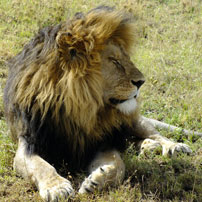 The walk finished with a well-earned bush breakfast on the Seketeti Escarpment with superb views over Lake Eyasi, several thousand feet below. This is also one of the spots Serian use for fly camping. The prospect of waking up to that view with coffee being brewed over an open fire and the smell of cooking bacon wafting over is mouth-watering and the inclusion of a multi-day walk with overnight fly camping as part of a longer trip is very tempting.
The walk finished with a well-earned bush breakfast on the Seketeti Escarpment with superb views over Lake Eyasi, several thousand feet below. This is also one of the spots Serian use for fly camping. The prospect of waking up to that view with coffee being brewed over an open fire and the smell of cooking bacon wafting over is mouth-watering and the inclusion of a multi-day walk with overnight fly camping as part of a longer trip is very tempting.
For a long time the eastern plains of the Serengeti were home only to researchers monitoring the cheetah population but over the past few years it has slowly been opening up to tourists, firstly with the arrival of Asilia Africa’s Namiri Plains, and now with the opening of Ehlane Plains, a sophisticated tented lodge with expansive vistas over the plains and offering, for the more adventurous, the chance to sleep under the stars on their three sleepout decks.
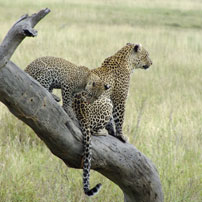
Whilst we roamed through the area on an extended game drive, we kept catching glimpses of long columns of wildebeest, all seemingly intent on running in different direction, but the stars of the show were without doubt the cats; a mother and baby leopard, majestic male lions and a coalition of cheetahs all made an appearance and reinforced our belief that this is a great area for cat sightings and for the time being at least (there are plans for more lodges to open there ) in a much quieter corner of the Serengeti.
Such is the quality of game viewing in Tanzania that you are never going to be disappointed with a safari here but the ability to factor in some time out of the vehicle and on foot adds another dimension to your stay. Whether that be a gentle walk in the Ngorongoro Highlands or a multi-day hike whilst fly camping, it is certainly worth considering!
